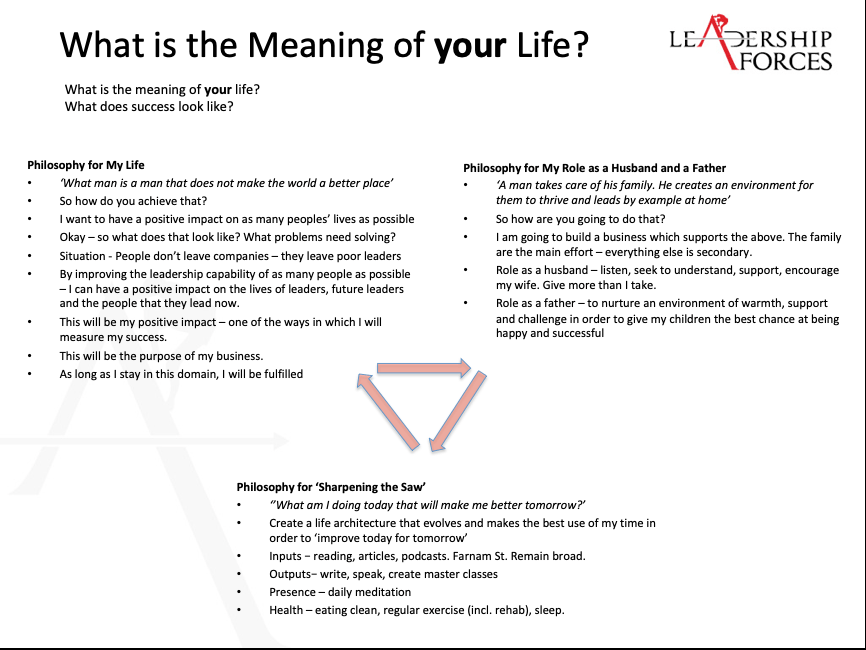You start with end in mind and work backwards to establish the steps that you need to complete that will take you from A to B. It’s something that most of us will have done at some point in our lives. If you want to move house, refit a bathroom or board a plane, you have to work out what you need to do and then the steps required to do it. This is a great example of tactical planning and we do it every day.
But do we apply the same process to our strategic goals?
I am not so sure. If you asked someone what does their career plan look like, they probably wouldn’t be able to give you an answer. Some might have a sense of their career direction but not many will have it written down and a plan to get there.
How likely are you to get where you want to go if you aren’t sure of the destination?
In Stephen Covey’s, ‘Seven Habits of Highly Successful People’, the first habit is to start with the end in mind. Covey asks the reader to picture their own funeral and then write four eulogies from the perspective of a family member, friend, colleague and a member of your community. It is designed to get you to think about ‘what a good life looks like’ by imagining what you want people to say about you when you die. Some people find the exercise a bit morbid; it’s not meant to be. It’s meant to get you to think differently about your life, your priorities and what you spend your time on.
Goals have value because if we know what we are working towards, it is much easier to tell if we are on the right path. If you are clear on where you want to take your career and you have a plan, you’re able to differentiate between an opportunity and a distraction. An opportunity takes you close to your goal; a distraction takes you further away from it.
A goal is different from a purpose. A goal is a destination, a vision for the future, a place you want to get to or something that you want to achieve. Goals are there to be achieved and then reset.
A purpose is deeper and more enduring than that. It answers the question, ‘how do you make the world a better place?’
I have spent some time thinking about this and have come up with the following diagram that explains my purpose and goal, which I created after I read Seven Habits of Highly Successful People.
It is relatively simple but it took me several hours of focused thinking time to create.
The value in this is that I now know what my life is all about. My business can fail (obviously I’d rather it didn’t) but so long as I continue to develop my expertise in coaching and developing people, it doesn’t matter. I understand what is important to me and how I contribute to make the world just a little better. So long as I stay within those boundaries, I will be professionally fulfilled.

I am also aware of the fact that I have different roles to play. I’m an entrepreneur, father and a husband. I need to balance these roles or I’ll end up being an absent parent. I believe that you lead by example and that leadership starts at home. You can’t help develop other teams unless you’re dedicated to developing your own team at home.
The last element at the bottom effectively answers the question, ‘how do I spend my time?’ because what you spend your time and money on demonstrates what you value. I am committed to self-development and I think about how I can spend time today ensuring that I am improving myself for tomorrow. I have learnt that this behaviour has a compound interest effect that improves both my life at home and my business. Some people might think that this is extreme and it probably is but I find it helpful to establish a philosophy that works for you, write it down and then live it.
Goal Orientation and Purpose are important but they have to be balanced with a sense of presence (being in the moment) and being open to opportunity.
Remaining open to opportunity is about ‘sticking your head up’ and checking to see if there are ways in which you can achieve your goal more efficiently or effectively. Whenever we start to work towards a goal, we bring with us assumptions and mental models that inform how we approach the goal. We need to remain open to the fact that our mental models and assumptions might not work or be the best ones to choose and that there might be better ways of doing things.
The obvious mental model that most entrepreneurs have is that ‘they need to work hard’. Everyone understands this and it is true but only to a point. If you’re working 14hr days for five years, I would suggest that working harder isn’t going to help achieve your goal, yet more often than not we have default approaches to problems that we don’t even take time to reflect on and then challenge. You cannot simply just ‘do more work’, you have to ruthlessly challenge what you are spending your time on and learn to say no to activity that doesn’t take you significantly closer to where you want to go.
Being present is about being focused on the current moment. This is a real challenge for ambitious people. They tend to be too future-focused. So, on their weekends, they’re preparing for that big pitch on Monday morning. They feel some guilt associated with not seeing their families and working late into the evenings but they justify it to themselves saying, ‘it’s what I have to do to provide for the family.’
Sometimes that might be true but is it about providing for your family or fulfilling your ambition? It is okay for it to be either, provided it is a deliberate choice.
In my next article, I am going to talk about systems thinking and offer some thoughts and tips on creating an environment that builds your resilience rather than degrades it.
This article is exclusive to The Business Transformation Network.
In case you missed it, you can read Part 1, Part 2 or Part 3 of the series here.





